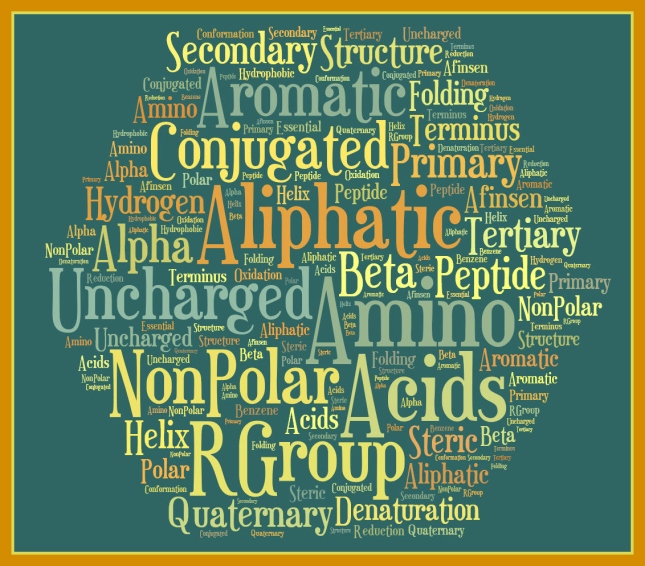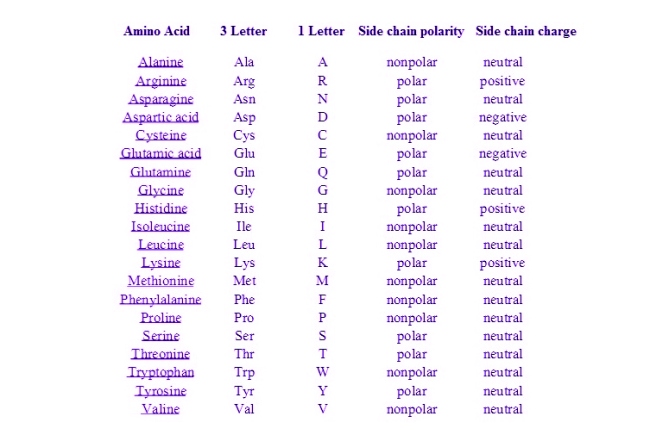We have been taught about the 20 essential amino acids, but do we know why they are essential to our bodies? Below is a list of their responsibilities and functions.

Alanine:
It is one of the
most significant among the
20 common amino acids. It
offers energy to your system. It releases into the blood stream during exercise time and induces carbohydrate-consuming effect to the health system. It
promotes enhancement in the area of
protein synthesis and
nitrogen balance.Arginine:
Synthesized normally in the body, arginine is known to be a
semi-essential amino acid. Sometimes more is required than normal production.
Deficiencies may include
poor wound healing, weakness in muscles, hair loss, irritations in skin, and constipation.
Asparagine:
It is needed to maintain homeostatic balance in the nervous system. Amino acid transformation and ammonia synthesis are largely dependent on asparagine.
Aspartic Acid:
Aspartic acid is one of two acidic amino acids belonging to the group of 20 common amino acids. It promotes enzyme activity, maintenance of solubility in the body, as well as homeostasis in ionic characters of proteins.
Cysteine:
It is present only at the rate of 2.8% into proteins but it provides the 3-dimensional stability of the protein molecule. It also plays a crucial role in the metabolic process of many important enzymes.
Glutamic Acid:
It is responsible for transportation of glutamate and other amino acids to the blood barrier.
Glutamine:
Glutamine is able to eliminate excess ammonia from the body system. It enhances immune system. Apart from that, glutamine possesses anti-anxiety property that permits the mind to be relaxed.
Glycine:
It helps in the transformation of harmful toxic substances within the body to a non-toxic form.
Histidine:
Histidine is required for infant development. Histidine deficiency may result in eczema, a kind of skin disease. There are few genetic disorders that promote non-metabolic state for histidine. This results in speech disorders and mental retardations among infants and toddlers.
Isoleucine:
This amino acid is particularly important for stimulating the brain in order to produce mental alertness.
Leucine:
It is particularly effective for producing other essential biochemical compounds in the body. These chemicals are important for producing bodily energy and mental alertness.
Lysine:
Lysine is important for proper
growth, and it plays an essential role in the
production of carnitine, a nutrient responsible for converting fatty acids into energy and helping to lower cholesterol. Lysine appears to
help the body absorb calcium, and it plays an important role in the
formation of collagen. It
functions against the
herpes virus in particular by
providing body required nutritional supplements.
Methionine:
It functions at
initiating the translation of messenger RNA.
Phenylalaine:
This amino acid profoundly
affects brain cells at biochemical level.
Proline:
It significantly affects human nutrition. It is believed to act as a source of nitrogen.
Serine:
Serine is intimately related to various bodily functions such as fat metabolism, tissue growth, enhancement of immune system and many more. It is an essential ingredient of brain protein.
Threonine:
It helps in the maintenance of protein balance and also in assisting collagen formation.
Tryptophan:
This is particularly needed in the body for the production of vitamin B3.
Tyrosine:
This is crucial in building link between dopamine and norepinephrine. It also reduces fat by suppressing appetite.
Valine:
It is effective in promoting tissue growth and maintaining nitrogen balance in the health system.




